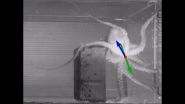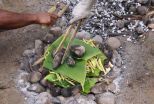(Press-News.org) The body plan of octopuses is nothing if not unique, with a sophisticated brain in a soft, bilaterally symmetrical body, encircled by eight radially symmetrical and incredibly flexible arms. Now, researchers reporting the first detailed kinematic analysis of octopus arm coordination in crawling show that the animals have a unique motor control strategy to match their "odd" form. The researchers report their findings in the Cell Press journal Current Biology on April 16.
"Octopuses use unique locomotion strategies that are different from those found in other animals," says Binyamin Hochner of The Hebrew University of Jerusalem. "This is most likely due to their soft molluscan body that led to the evolution of 'strange' morphology, enabling efficient locomotion control without a rigid skeleton."
Earlier studies of octopus behavior by The Hebrew University of Jerusalem team have focused on goal-directed arm movements, like reaching to a target or fetching food to the mouth, Hochner explains (for instance, see http://www.eurekalert.org/pub_releases/2006-04/cp-hto041306.php, http://www.eurekalert.org/pub_releases/2014-05/cp-hod050714.php, and http://www.eurekalert.org/pub_releases/2011-05/thuo-hur051811.php). The new study is the first to tackle a larger question: how octopuses manage to coordinate their eight long, flexible arms during locomotion.
Octopuses most likely evolved from animals more similar to clams, with a protective outer shell and almost no movement to speak of. "During evolution, octopuses lost their heavy protective shells and became more maneuverable on the one hand, but also more vulnerable on the other hand," says study co-author Guy Levy. "Their locomotory abilities evolved to be much faster than those of typical molluscs, probably to compensate for the lack of shell."
The evolution of a typical snail's foot into long and slender arms gave octopuses extraordinary flexibility. Excellent vision, together with a highly developed and large brain and the ability to color camouflage, made cephalopods very successful hunters. But how do they control the movements of those remarkable bodies?
After poring over videos of octopuses in action, frame by frame, the researchers made several surprising discoveries, as reported in the new study. Despite its bilaterally symmetrical body, the octopus can crawl in any direction relative to its body orientation. The orientation of its body and crawling direction are independently controlled, and its crawling lacks any apparent rhythmical patterns in limb coordination.
Hochner, Levy, and their colleagues show that this uncommon maneuverability of octopuses is derived from the radial symmetry of their arms around the body and the simple mechanism by which the arms create the crawling thrust: pushing-by-elongation.
"These two together enable a mechanism whereby the central controller chooses in a moment-to-moment fashion which arms to recruit for pushing the body in an instantaneous direction," the researchers write. The animal needs only to choose which arms to activate in order to determine the direction of locomotion.
The findings lend support to what's known as the Embodied Organization concept. In the traditional view, motor-control strategies are devised to fit the body. But, the researchers say, under Embodied Organization, the control and the body evolve together in lockstep within the context of the environment with which those bodies interact.
"This concept, which is borrowed from robotics, argues that the optimal behavior of an autonomous robot or an animal is achieved as a result of the optimization of the reciprocal and dynamical interactions between the brain, body, and the constantly changing environment, thus leading to optimal adaptation of the system, as a whole, to its ecological niche," Levy says. "Another important virtue of this type of organization is that every level, including the physical properties and the morphology, contribute to the control of the emerging behavior--and not only the brain, as we tend to think."
Levy and Hochner say their next step is to uncover the neural circuits involved in the octopuses' coordinated crawling.
INFORMATION:
Current Biology, Levy et al.: "Arm Coordination in Octopus Crawling Involves Unique Motor Control Strategies" http://dx.doi.org/10.1016/j.cub.2015.02.064
Current Biology, published by Cell Press, is a bimonthly journal that features papers across all areas of biology. Current Biology strives to foster communication across fields of biology, both by publishing important findings of general interest and through highly accessible front matter for non-specialists. For more information please visit http://www.cell.com/current-biology. To receive media alerts for Current Biology or other Cell Press journals, contact press@cell.com.
Bacteria that naturally reside in the gut are important for health, but recent studies consistently show that a modern lifestyle depletes the gut's collection of microbes. How lifestyle affects the diversity of this gut "microbiome" is unclear, but an analysis of the gut microbiomes of Papua New Guinean and US residents in Cell Reports now suggests that western lifestyle may diminish the variety of bacteria in the gastrointestinal tract by limiting their ability to be transmitted among humans.
"There are several aspects of western lifestyle that have been hypothesized ...
Oral infections are the most common diseases of mankind and are also a key risk factor for heart disease, which is the leading cause of death worldwide. In a review article published in Trends in Endocrinology and Metabolism on April 16, researchers summarize the latest clinical evidence supporting a link between oral infections, which are caused by the bacteria in our mouth, and heart disease, and they emphasize the important role of inflammation in both of these conditions.
"Given the high prevalence of oral infections, any risk they contribute to future cardiovascular ...
By analyzing the activity of "GPS" neurons in mice, researchers at the Stanford University School of Medicine have discovered that the mental maps created by these cells accumulate errors, which are corrected when the animal encounters a wall.
The findings support the theory that these cells, called grid cells, use an animal's perceived speed and direction to help it navigate familiar places.
Thus, as you stumble through your pitch-black kitchen in the middle of the night for a glass of water, your body knows how many steps to take and when to turn to get to the sink. ...
Men give more money through fundraising websites after seeing that other men have donated large amounts and when the fundraiser is an attractive woman, according to new UCL and University of Bristol research.
The scientists say this response by men is unlikely to be conscious and could have an evolutionary function as theories predict that generous actions can honestly signal hidden qualities, such as wealth or desirable personality attributes, to potential partners.
Co-author Dr Nichola Raihani from UCL (Life Sciences), said: "We looked at why people behave generously ...
A nerve neglected in today's era of molecular and genetic analysis has yielded a surprising secret. A handful of neurons control breathing in a fine-tuned but powerful way, scientists have discovered in mice. Among these sensory neurons, two types are dedicated to two specific respiratory functions.
The findings, published in Cell, suggest new ways of considering clinical conditions related to the vagus nerve.
The team, led by Stephen Liberles, Harvard Medical School associate professor of cell biology, has effectively deconstructed the vagus nerve, a key connection ...
The enzyme AMPK initiates a dizzying array of cellular activities, from breaking down worn-out cellular parts to turning on energy production. How does a single protein, activated by a single switch, fulfill so many different tasks without getting them mixed up? To get at such a complex question, cell biologists at Johns Hopkins designed several molecular tools that allowed them to watch, measure and manipulate the activity of the enzyme AMPK in individual compartments within the cell. The new tools have confirmed that at least some of AMPK's ability to multitask comes ...
Angiogenesis inhibitors--a widely used class of cancer drugs designed to shrink tumors by preventing them from forming new blood vessels--often work in the short term, but usually become ineffective within months. Now, a team led by UC San Francisco scientists has discovered a possible reason, one that could lead to a way to address the problem and prevent cancer relapse.
Working with laboratory models of pancreatic and breast cancer, the scientists found that myeloid cells, which originate in bone marrow and are part of the body's first-line of defense--the so-called ...
How does climate change affect the occurrence and distribution of species? This is a key question in the climate debate, and one that is hard to answer without information about natural variation in species abundance. Now researchers from Uppsala University can, for the first time, give us a detailed picture of natural variation through a major study published today in the leading scientific journal Current Biology.
The impact of climate change on species occurrence and distribution is a central issue in the climate debate, since human influence on the climate risks posing ...
The nutrients excreted by fish in their "pee" may be critical to the health of coastal ecosystems. But knowing whether generalizations can be made about how to predict these nutrient levels in various ecosystems has vexed researchers - until now.
In a paper published in Proceedings of the National Academy of Sciences, North Carolina State University associate professor Craig Layman and colleagues show that ecologists can better predict the rates of how these chemical nutrients are transferred by fish if they know the various fish species living in an ecosystem, along ...
An international team of scientists, led by researchers at University of California, San Diego School of Medicine, have found genetic overlap between Alzheimer's disease (AD) and two significant cardiovascular disease risk factors: high levels of inflammatory C-reactive protein (CRP) and plasma lipids or fats. The findings, based upon genome-wide association studies involving hundreds of thousands of individuals, suggest the two cardiovascular phenotypes play a role in AD risk - and perhaps offer a new avenue for potentially delaying disease progression.
The findings ...



